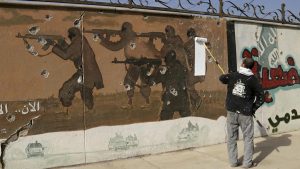ISIL’s shift to guerrilla tactics has been underway since early last year. As the group lost more territory, it gradually adjusted its tactics to adapt to its new environment and to the relentless air and ground campaign against it. But on October 12, ISIL officially telegraphed its intention to switch to full insurgency mode. The group’s Arabic bulletin Al Naba published a report detailing the last time the organisation was obliged to do the same. Such a shift, the report added, has now become a necessity. The report puts into perspective the way the militants have been fighting, or not fighting, over the past month, like reported by thenational.ae.
According to the report, the group’s previous incarnation, known as the Islamic State of Iraq, had become too weak to engage in fighting after intense battles throughout 2006 and 2007. The group was then on the run in Iraq and its top leaders at the time, Abu Omar Al Baghdadi and Abu Hamza Al Muhajir, felt compelled to make what the bulletin described as an “unprecedented and bold decision”.
“In early 2008, it became clear that it was impossible to continue to engage in conventional fighting,” stated Al Naba. “That was when Abu Omar Al Baghdadi said: ‘We now have no place where we could stand for a quarter of an hour.’”
Al Muhajir, the group’s war minister at the time, then deemed it necessary to dismantle all fighting, sniper and other units in order to preserve what was left of his fighters. Starting in March 2008, the remaining cadres were instead trained on using improvised explosive devices (IEDs). The new strategy, the report said, involved four different units — two focused on making explosives and detonating devices separately, another on planting the IEDs while the fourth was tasked with monitoring the location, sometimes for days, to detonate when a target reaches it.
The report mentioned that members were not all convinced by the shift but they quickly bought into the tactic, and emphasised that the shift to these tactics is more necessary now, especially given the intensity of the United States-led air campaign.
The message of Al Naba’s report is consistent with ISIL’s modus memoranda in recent weeks. Unlike in Raqqa until a month ago, the militants have tended to refrain from conventional street-to-street fighting in areas like Deir Ezzor and Anbar ever since. In another edition of Al Naba, ISIL also indicated that it would no longer engage in drawn-out urban fighting after Raqqa, in a series on lessons learned from the international air campaign against it.
The general tendency is to explain these swift retreats as a sudden crumbling of the organisation after its defeat in Raqqa. But even American officials privately expected fighting in places like Deir Ezzor and Anbar to run well into next year. These areas include the remaining concentration of ISIL’s forces, including fierce fighters and key commanders preserved from previous battles. They also include at least 550 fighters who were recently given a free passage by Hizbollah and the Syrian Democratic Forces from Lebanon and Raqqa, respectively.
A better explanation, consistent with ISIL’s own publications, is that the group has decided to switch fully to insurgency tactics in areas it considers key to its next strategy. This approach, as the author frequently highlighted over the past few years, is what the group refers to as nikaya, a war of attrition to deplete its enemy through a ceaseless and incessant campaign of terror and hit-and-run attacks. Starting from October, as Al Naba suggested, this strategy is now in full swing. It is what will define ISIL’s campaign in Iraq and Syria in the coming years.
ISIL speaks about its existence as a continuum, with its formative years as one chapter of its continuing story. Its enemies, on the other hand, tend to be forgetful. Just three years ago, its enemies were searching for answers to questions like: What made the group so successful? What does it want? How was it able to control so much territory in so little time? What became of the social and political grievances that, as both observers and politicians then recognised, created the space for ISIL’s rise? Have they been resolved? Or do they no longer need to be part of the conversation? Today, many of these questions related to deeper causes seem less relevant. The group has been militarily defeated, after all.
As ISIL launches its next chapter, policymakers should maintain perspective of the debates at the time. They should also note that the group was once defeated much more thoroughly than today. In 2010, for example, Iraqi authorities dismantled the group’s most serious cell, in Baghdad, and arrested its commander there. The commander’s capture then led to the killing of the group’s overall leader along with his deputy.
In a 2010 report, CNN interviewed the commander, Manaf Al Rawi, who admitted the group had been hit hard. Its loss of territory, he said, deprived it from the ability to build car bombs and plan attacks. The report pointed out that the group failed because its vicious tactics alienated the communities it sought to win, and an American general indicated that he took comfort in the fact that Iraqis did not buy into its ideology. Finally, the reporter asked Al Rawi whether he thought his organisation was “falling apart”.
The conversation has a familiar tone to those taking place today. At the time, Washington was preparing to declare victory and withdraw from Iraq. In contrast to its enemies then and now, ISIL maintains a sense of continuity to its existence and touts its persistence as vindication of a preconceived and preordained plan. In reality, its persistence is made possible in large part because its enemies lack this sense of continuity.



